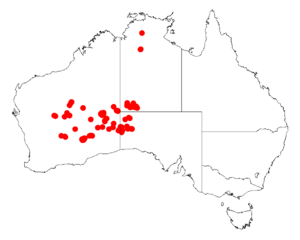Helm's wattle facts for kids
Quick facts for kids Helm's wattle |
|
|---|---|
| Scientific classification | |
| Genus: |
Acacia
|
| Species: |
helmsiana
|
 |
|
| Occurrence data from AVH | |
Helm's wattle (scientific name: Acacia helmsiana) is a type of shrub. It belongs to the Acacia family, which is also known as wattles. This plant only grows naturally in the dry, desert-like parts of central and western Australia. It's a special plant because it's endemic, meaning it's found nowhere else in the world.
Contents
What Helm's Wattle Looks Like
Helm's wattle is a bushy shrub that spreads out. It usually grows between 0.45 to 2 meters (about 1.5 to 6.5 feet) tall. Its branches often start right from the ground.
The young branches are smooth and shiny, like they have a bit of sticky resin on them. They are brown and slightly angled at the ends. They have tiny leaf-like parts called stipules. The bark on the older parts is grey or reddish-brown.
Like many Acacia plants, Helm's wattle doesn't have regular leaves. Instead, it has phyllodes. These are flattened leaf stems that act like leaves. The phyllodes of Helm's wattle are always green and also have a resinous, sticky feel. They can be round or slightly flattened. They are about 1 to 2 centimeters long and 0.5 to 1.5 millimeters wide. They might be straight, curved, or even slightly S-shaped. You might see two faint, brownish lines on them, which are veins.
Flowers and Seed Pods
Helm's wattle blooms from June to November, making bright yellow flowers. Its flowers grow in simple groups called inflorescences. These groups appear one by one where the leaves meet the stem (called the axil). Each flower group is a round ball with 20 to 30 light to medium golden-colored flowers.
After the flowers, seed pods form. These pods are strongly curved or even coiled up. They are about 4 centimeters long and 4 millimeters wide. Inside, the seeds are arranged lengthwise.
How Helm's Wattle Got Its Name
Scientists give plants special names to help identify them. The first time Helm's wattle was officially described was in 1920. A botanist named Joseph Maiden wrote about it in a scientific paper.
Later, in 2003, another botanist named Leslie Pedley tried to change its name to Racosperma helmsianum. But by 2006, it was changed back to its original Acacia name.
The second part of its scientific name, helmsiana, is a way to honor someone. It's named after Richard Helms (naturalist), who was an explorer and naturalist. He collected the very first plant sample of Helm's wattle. This first sample is called the type specimen. He found it during a trip called the Elder Expedition.
Where Helm's Wattle Grows
Helm's wattle grows naturally in specific dry areas of Australia. You can find it in the northwest part of South Australia, the southwest of the Northern Territory, and the Goldfields region of Western Australia.
It likes to grow on sand dunes and sandy plains. It prefers red or yellow sandy soils. Most of these plants are found from places like Wiluna in the west, all the way to Mount Olga in the Northern Territory in the east. It often grows as part of open areas with spinifex grasses. In South Australia, it is only found around the Serpentine Lakes area.

